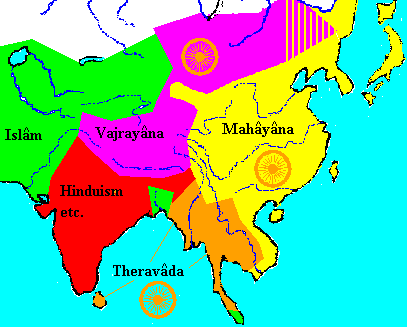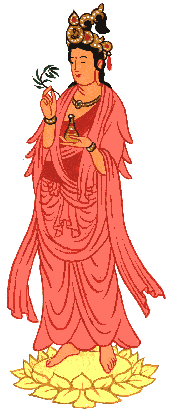Buddhism is a collective name for the diverse philosophical, esoteric and religious beliefs that are derived from the way of liberation taught, in the 6th century B.C., by the North-Indian prince Siddhartha Gautama, called the Buddha, which means the Awakened or Enlightened One. Advayavada Buddhism, formally established in 1995 as a new, secular branch of Mahayana Buddhism by the Dutch lay Buddhist author and translator Advayavadananda (John Willemsens, b.1934), is a non-dual and life-affirming philosophy and way of life derived in turn from Nagarjuna’s Madhyamaka, or philosophy of the Middle Way. The purpose of Advayavada Buddhism is to help us to become a true part of the whole. Because of its open character and structure, and, above all, its autonomous and non-prescriptive nature, it is difficult to determine how many Buddhists share the views of Advayavada Buddhism worldwide at this time.

According to Advayavada Buddhism, it is indisputable that the Buddha did not believe in Brahman (God, transcendent and immutable Absolute) or in the atman or atta (soul, immortal self) and taught that man suffers because he does not understand and accept that all things in life are instead utterly changeable and transitory; if the Buddha had ever expressed belief in Brahman and the atman or atta, such a fact would have been unequivocally recorded in History. Man is prone to suffering (duhkha, dukkha) quite simply because he wrongly strives after and tries to hold on to things, concepts and situations which he believes to be permanent, but are not.
Man’s mistaken view of things is produced by a thirst or craving (called trishna in Sanskrit and tanha in Pali) which is in turn caused by his fundamental ignorance (avidya, avijja) of the true nature of reality. And this thirst or craving can easily take on a more unwholesome form: already as sensuous desire, ill-will, laziness, impatience or distrust will it seriously hinder any efforts to better his circumstances.
His compliance, however, with the five precepts that apply to all followers of the Buddha will allow him to arrest his thirst or craving and to commence removing the root cause of his suffering, i.e. his fundamental ignorance of the true nature of reality. The five fundamental Buddhist precepts are not to kill, not to steal, sexual restraint, not to lie, and abstinence from alcohol and drugs. Man’s observance of these precepts in his daily life gives him the moral strength required to embark upon the Buddha’s Middle Way that, avoiding first the extremes of self-indulgence and self-mortification, will in due course bring him to the blessed state of Nirvana.
Nirvana is the complete extinction (nirodha) of all suffering (duhkha, dukkha) as a result of our full reconciliation with reality as it truly is. Nirvana and Samsara are not two different realities or two different conditions of reality. Nirvana is to experience the phenomenal world at the level of ultimate truth (paramartha-satya), i.e. truth divested of all our preconceptions, including even those expressed here. Samsara is to experience the same phenomenal world at the level of conventional everyday truth (samvriti-satya). It is as a result of the purification of our perception of the phenomenal world at the level of conventional truth by following the Buddha’s Middle Way, that we shall come to understand the significance of ultimate truth and its rewards.
The Middle Way devoid of extremes that we must follow is concretely the Noble Eightfold Path that the Buddha taught in his very first sermon in Sarnath, near Benares. The Noble Eightfold Path, when interpreted dynamically as an autonomous and creative process of progressive insight reflecting in human terms wondrous overall existence becoming over time, as Advayavada Buddhism does, is that of our very best (samyak, samma) comprehension or insight, followed by our very best resolution or determination, our very best enunciation or definition of our intention, our very best disposition or attitude, our very best implementation or realization, our very best effort or commitment, our very best observation, reflection or evaluation and self-correction, and our very best meditation or concentration towards an increasingly real experience of samadhi, which brings us to a yet better comprehension or insight, and so forth. We thus regain our place in totality advancing over time, in human terms, towards better and better, breaking, as we advance along the Path, the fetters (samyojana) that restrict us to Samsara.
Advayavada Buddhism indeed considers progress (pratipada, patipada) as the fourth sign of being, this next to the impermanence and the selflessness of all things and the ubiquity of suffering in the world, which are the three signs or marks of being traditionally taught in Buddhism. When the Path expounded by the Buddha as the correct existential attitude and way of life is viewed as an ongoing reflexion at the level of our personal lives of wondrous overall existence becoming over time, it follows that human beings experience as good, right or beneficial that which takes place in the otherwise indifferent direction that time-being as a whole flows in of its own accord. The teaching of the Buddha must be seen as a Way of Reconciliation with wondrous existence as a whole just right as it is, i.e. as it truly is beyond our commonly limited and biased personal experience of it. Nirvana is, in Advayavada Buddhism, the ultimate reconciliation with reality becoming achievable by man. Indeed, in certain schools of Buddhism, Nirvana itself is seen as the fourth sign of being or seal of the dharma.


